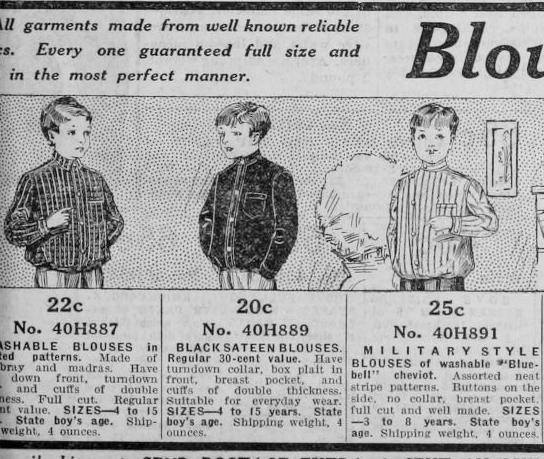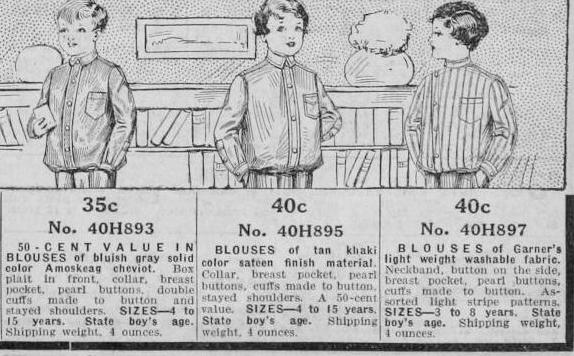
Sears Ucanttear Blouses (1912)

Figure 1.--Sears Ucantear brand offered sixsttles of boys' blouses in 1912. They werenosrky sized 4-15 yearsofahe. But there were blouses sized for the younger boys 3-8 years. Thesewere the side-buttoning style which Searscalled a military style. It looks to us like what was also called a Russian blouse.
|
|
American boysduring the 1910s wore blouses, shirts, and shirt waists. The difference between a blouse and shirt was that blouses did not have shirt tails which is how shirts were tucked into the pants. Blouses at the time in contrast has drawstring clousres causing them to blouse out, thus the name. Modern blousesdo not blouse out, but the name hasstuck. Blouses in the 1910s were still very common for younger boys. They were not worn by adult men, but were worn by girls and women. Some were still done in sizes for teenage boys. We note blouses being offered by Sears in many different styles as part of the Ucanttear brand offerings. They were were done for boys 4-8/15 years of age, depending on the style.
The Sears, Roebuck and Co., huge merchandising firm centered in Chicago was founded by Richard W. Sears (1863-1914) and A.C. Roebuck (1864-1948). Sears had begun a career in mail-order business in Minnesota 1886. In Chicago he and Roebuck joined resources and formed a corporation in 1893 as a mail-order business under title Sears, Roebuck and Company. Julius Rosenwald (1862-1932) in 1895 bought Roebuck's interest in firm and became president on Sears's retirement 1908. A retail-store system was added 1925. The first foreign store added in Havana, Cuba during 1945 and becane te first expropriated store in 1960. The Sears-Roebuck brought the production of industry to the fartherest corner of rural America, opening the cornucopia of the consumer age to rural America. All the new things that were changing American life danced across their pages. Through it, a huge Chicago warehouse offers to modernize the farms and small towns of the Midwest.
Ucanttear
Ucanttear was a Sears brand. It was of course Sears claim that these were garment that even boys couldn't tear up. The name is clerly an aliteration of "You can't tear," emphasizing the toughness of the product. We are not sure when Sears first began using this brand. We first note Ucantear suits in 1909. At thit time we see knicker suits. We see Ucantear junior suits in 1912. Here there were a number of tunic suits. We have also archived some vintage Ucanttear items.
Perhaps the most famous blouses worn by American boys were the Fauntleroy blouses with lace or ruffled collars during the 1880s and 90s. Most of the these were blouses with attached collars and cuffs. All were long sleeves. Some of the lace collars pinned on, but many of the large collars seen in the old photgraphs are blouses with attached collars. These blouses came in a wide variety of styles. They were most notable for the sometimes huge size of the collar and matching cuffs. This contrasts with the Eton collars which almost always were detachable collars. Yonger boys increasing in the 1930s began wearing the American version of an Eton suit. The first ones appear to have been worn with detachable Eton collars, but soon blouses with small Eton-style collars appeared. Gradually the Peter Pan collar began to replace the Eton collar wore with these suits. Some American boys wore blouses until about the 1980s when they became less common. Blouses were mostly worn by boys from affluent families, primarily by boys not yet of school age. A few school age boys to about 6 or 7 might wear blouses. Most of the older boys wearing blouses wore ones with Peter Pan collars often with Eton suits. By the 1980s, blouses were only worn by very young children or for formal occasions like weddings. radually the Peter Pan collar began to replace the Eton collar wore with these suits.
Inividual Ucanttear Blouses
These blouses were offered on the same Sears catalog page as Ucanttear knee pants. The blouse caption read,"All garments madefrim well known reliable sources. Everyone guaranteed full sizeabd in the most perfect manner." It seems to relate to both the blouses and knee pants. There was no specificcaption relating to the blouses. Some of the blouses had destinctive names, otherswere just referred to as blouses. They are notable for the lack of destinctive collars. Notice thast the illustrations show younger boyswearing them even thought most were made in teenage sizes. They were all long-sleeve garment. short sleeveswill still not common for boysin the910s. There is no mention of it in the adcopy, but the bloucing affect is achieved by a drawstring clousure at the waist bottom.
No. 40H887 Washable blouses -- 22c
The adcopy read, "Washable blouses in varied patterns. Made of chambray [we think] and madras. Have ??? down front, rurndown [collar?] and of double thickness. Full cut. Regular ???ut value. Sizes -- 4-15 years. State boy's afe. Shipping weight, 4 ounces." the weight was needed to calculate postage." Chambray is a fine cloth of cotton, silk, or linnen, commonly of plain weave with a colored warp and a white weft.
No. 40H889 Black sateen blouses -- 20c
The adcopy read, " Black sateen blouses. Reguklar 30-cent value. Have turn down collar, boxplait in front, breast pocket, and cuffs of doubke thickness. Suitable for everyday wear. Sizes -- 4 to 15 years. State boy's age. Shipping weight, 4 ounces." Sateen was a cotton material with a sheen that made it similar to satin for added softness.
No. 40H891 Military style blouses -- 25c
The adcopy read, "Military style blouses of washable 'Bluebell' cheviot. Assorted neat strip patterns. Buttonson the side, no collar, breast pocket, full cut andwell made. Sizes -- 3 to 8 years. State boy's age. Shipping weight, 4 ounces." Sears calls this a military style. We think this is also known as a Russian blouse, although we are not entirely sure. Notice that this was only a style for the younger boys.

Figure 1.--Here aretheother three blouses offerd by Sears in 1912.
|
|
No. 40H893 50 - cent value -- 35c
The adcopy read, " 50 - cent value in blouses of bluish gray solid color Amoskeag cheviot. Box plait in front, collar, breast pocket, pearl buttons, double cuffs, made to button andstayed shoulders. Sizes -- 4 to 15 years. State boy's age. Shipping weight, 4 ounces." Amoskeag refers to fallsin Manchester New Hampshire that powered early mills. Thiswas presumabky where the fabric wa sproduced. Cheviot was a distinct weave used for suiting in wool and shirting in cotton as in this case.
No. 40H895 Blouses of tan khaki -- 40c
The adcopy read, "Blouses of tan khaki color sateen finish material. Collar, breast pocket, pear buttons, stayedshoulkders. A 50 cent value. Sizes -- 4 to 15 years. State boy's age. Shipping weight, 4 ounces." We were a little surprised about the khani color. It looked like adress shirt in the illustration.
No. 40H895 Blouses of Garner's light weight washable fabric -- 40c
The adcopy read, "Blouses of Garner's light weight washable fabric. Neckband, buttons up the side, breast pocket, pearl buttons, cuffs madeto button. Assorted light stripe patterns. 3 to 8 years. State boy's age. Shipping weight, 4 ounces."
HBC

Navigate the Boys' Historical Clothing catalog/magazine pages:
[Return to the Main American mail order 1912 page]
[Main photo/publishing page]
[Store catalogs]
[Fashion magazines]
Navigate the Boys' Historical Clothing Web Site:
[About Us]
[Introduction]
[Activities]
[Biographies]
[Chronology]
[Clothing styles]
[Countries]
[Girls]
[Theatricals]
[Topics]
[Bibliographies]
[Contributions]
[FAQs]
[Glossaries]
[Images]
[Links]
[Registration]
[Tools]
[Boys' Clothing Home]
Navigate the Boys' Historical Clothing Web Site:
[Sailor hats]
[Flat caps]
[Sailor suits]
[Buster Brown suits]
[Eton suits]
[Rompers]
[Tunics]
[Smocks]
[Knickers]
[Long stockings]
[Pinafores]
[Underwear]
Created: 5:59 AM 2/1/2019
Last updated: 10:20 PM 2/1/2019




